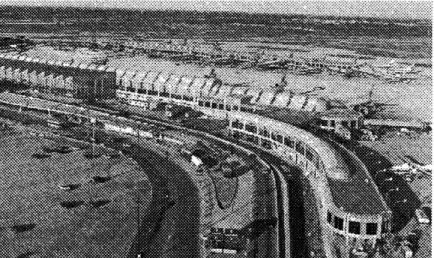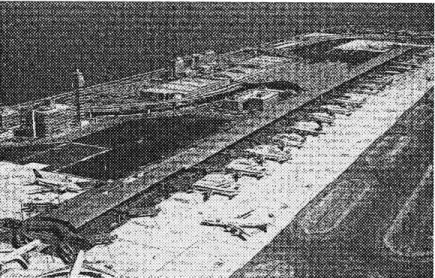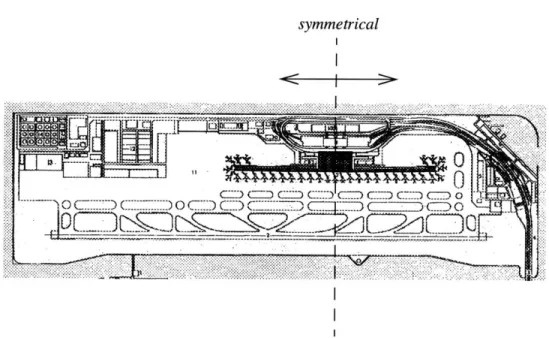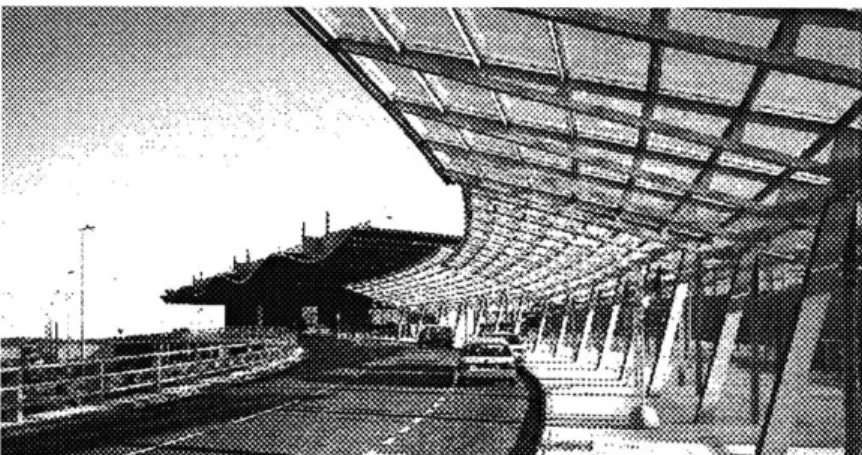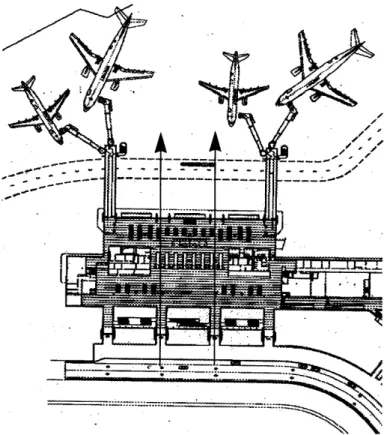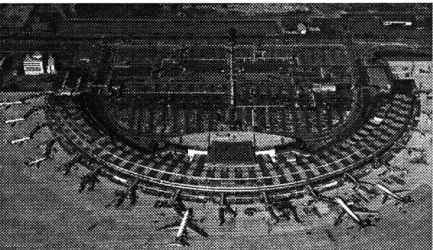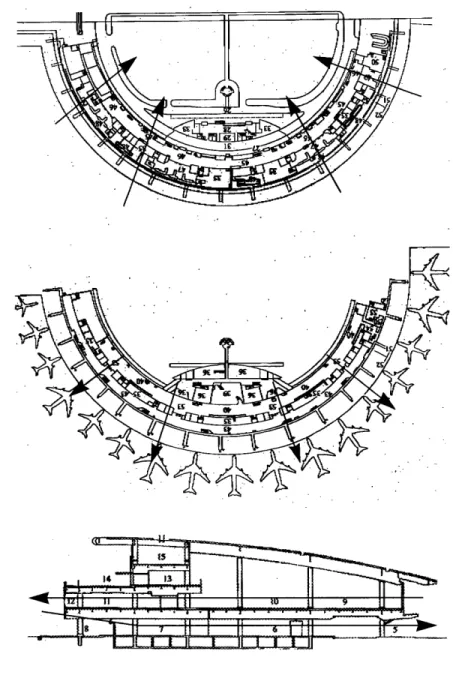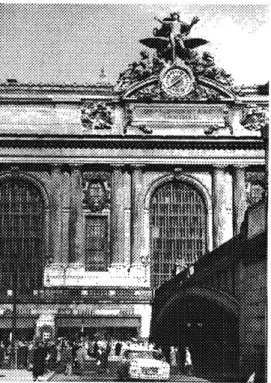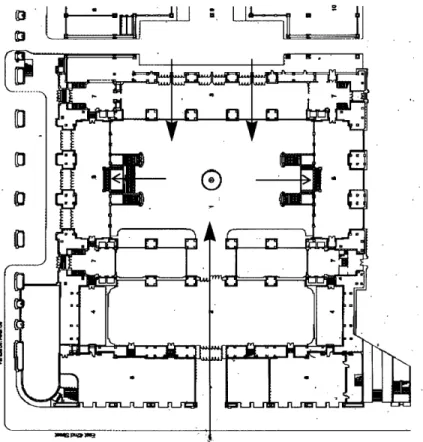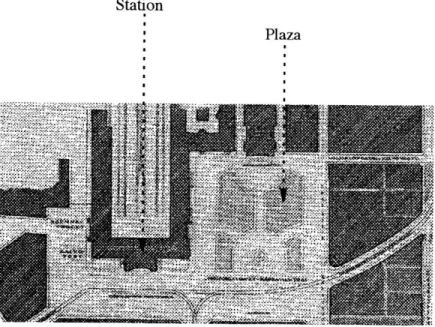Celebration of arrival and departure:
Airport as threshold between sky and ground
by Yoshiyuki Watanabe
Bachelor of Economics Keio University, Tokyo, Japan March 1989
Submitted to the Department of Architecture
in partial fulfillment of the requirements for the degree of
Master of Architecture at the Massachusetts Institute of Technology February 1998
@ Yoshiyuki Watanabe 1998. All rights reserved. The author hereby grants to MIT permis-sion to reproduce and to distribute publicly paper and electronic copies of this thesis docu-ment in whole or in part.
Signature of the author ... ... ... I ...
Yoshiyuki Watanabe Department of Architecture January 16, 1998
C ertified b y ...
Michael McKinnell Professor of The Practice of Architecture Thesis Advisor
A ccepted b y ... Roy Strickland Associate Professor of Architecture Chairperson, Departmental Committee of Graduate Students
Iji
A
2
7y
Celebration of arrival and departure:
Airport as threshold between sky and ground
by Yoshiyuki Watanabe
Bachelor of Economics Keio University, Tokyo, Japan March 1989
Submitted to the Department of Architecture
in partial fulfillment of the requirements for the degree of
Master of Architecture at the Massachusetts Institute of Technology February 1998 Thesis Reader: Title: Thesis Reader: Title: Chris Luebkeman Assistant Professor of Takehiko Nagakura Assistant Professor of Architecture Architecture
Celebration of arrival and departure:
Airport as threshold between sky and ground
by Yoshiyuki Watanabe
Submitted to the Department of Architecture
in partial fulfillment of the requirements for the degree of
Master of Architecture at the Massachusetts Institute of Technology February 1998
Abstract
An airport terminal building celebrates arrival and departure as the gate to a city and the sky. However, many contemporary airport terminals do not play the role as a gate. Circulation is often uninspiring and monotonous, and as a result disengages the city from the sky. These terminals adopt the "Uniform Circulation" which let passengers simply move from one side to the other. This circulation comes from not site conditions but operational requirements. This thesis explores airport terminal design with an alternative circulation coming from site conditions.
In Kagoshima, Japan, I propose an airport terminal build-ing designed as a gate. Kagoshima City is located close to Sakurajima, an active volcano visible from the site. The volcano offers a contrasting marker between sky and ground, a natural counterpart to the man-made gate that is the airport.
Thesis Supervisor: Michael McKinnell
Acknowledgments
Thanks to Michael McKinnell. You are the best teacher I have ever met in my life.
Thanks to my readers, Chris Luebkeman and Takehiko Nagakura.
Thanks to my sisters, my brothers, and Yaeko Suzuki for your supports.
This thesis is dedicated to my parents for all their years of love, supports, and invaluable guidance.
Table of Contents
A b stra c t...5 Acknowledgments ... ... 7 Table of Contents ... 9 Intentions ... 11 Precedent Study ... 13Old Railroad Stations ... 29
Site and Program ... 35
D e sig n ... 4 1 Process: Sketch M odels ... 45
S ite ... 4 8 Arrival and Departure at the New Kagoshima Airport Terminal .... .... 52
Drawings ... 64
Conclusion... 75
Figure Credits ... 77
Bibliography ... 79
Intentions
curb-side Circulation, which physically and mentally relates a building to its
sur-roundings and makes the building special and unique, is often very uninspiring in airport terminal building design. Many contemporary air-port terminals use "Uniform Circulation," which comes not from their site conditions but from operational requirements. This thesis explores airport terminal design by introducing new circulation instead of the uniform circulation. The uniform circulation disrespectfully disassoci-ates worldwide airport terminals from their characteristic surroundings and makes them very monotonous.
Under the uniform circulation, both arriving and departing passengers simply move from one side to the other in an airport terminal building
(fig. 1). It can be seen all over the world. This uniform circulation
makes worldwide airport terminals not only self-generated and monoto-nous but also two-sided. From a design point of view, the facades of curb-side and airplane-side are particularly considered but the other two facades, which are normally assigned with glass windows, seem to be less taken care of. In that sense, the airport terminals lose two faces out of four. This thesis challenges these architectural problems by propos-ing an airport terminal with alternative circulation.
An airport terminal building is a gate between ground and sky. A gate is built to symbolize an entry to a particular place, associate the place with another, celebrate people's arrival and departure, and prepare them for the entry into a different world (fig. 2). Because a gate is characteristic of the place where it stands, an airport terminal must have its own circu-lation designed by its own site conditions, not by standardized opera-tional requirements. This alternative circulation engages a city with the sky, makes the airport terminal special and unique, and makes it the "gate."
In Kagoshima, Japan, I propose a new airport terminal designed as a gate. Kagoshima City is located very close to Sakurajima, an active
I
airplane-side
9-.
departure
-fig. 1: Uniform Circulation
One side to the other
arrival
fig. 2: Gate on the Sea: Itsukushima Shrine
volcano visible from the site (fig. 3). Unfortunately, travelers do not notice Sakurajima from the existing old Kagoshima Airport Terminal because of the uniform circulation which has no relation with its own site conditions including the magnificent view of Sakurajima. The existing terminal is a typical example of unin-spiring circulation. I intend to replace the existing terminal with a new one using alternative circulation. Sakurajima is the key to my design of the new Kagoshima Airport Terminal. This active vol-cano offers a contrasting marker between sky and ground, a natu-ral counterpart to the man-made gate that is the airport.
fig. 3: Sakurajima (active volcano)
View of Eruption
This volcano is surrounded by the Kinko Bay and is vis-ible from the site.
Kagoshina Airport
(site) Kinko Bay
N Sakurajima
Kagoshima City
fig. 4: Site Model (]"=3,000')
Precedent Study
Many contemporary airport terminals use the uniform circulation. The uniform circulation basically has four configurations (fig. 5). As the figure shows, both depart-ing and arrivdepart-ing passengers simply move from one side to the other side, and do not turn around or look back. All airport terminals shown below can be categorized into any of these types.
Type (a), a prototype of the uniform circulation, is used in the Stansted Airport Terminal. The key to the terminal layout is the desire of Foster Associates to return to the simplicity and convenience of the early days of flying.1 Type (b), which is widely used for contemporary airport terminal design, is used in the Dulles International Air-port Terminal, Chicago O'hare International U.A. Termi-nal, Kansai International Airport TermiTermi-nal, San Pablo International Airport Terminal, Bordeaux Airport Terni-nal B, New Chitose Airport TermiTerni-nal, and Hiroshima Air-port Terminal. Pointe a Pitre AirAir-port Terminal is type (d). It has an advantage that the baggage claim area, normally put into a dark and compressed space under a low ceiling, can have a broader and brighter space.
Arrows in figures 5 and 6 represent passenger flows. The passenger flow as well as an assignment plan of service areas must be constructed as follows. A departing passen-ger moves from a car, a taxi, or a bus to an airplane through check-in counter, security check, and departure lobby. An arriving passenger moves from an airplane to
B4ggaje Claim
Arrival
(d)
Swmw.vabqaWdwatw ripfwam
fig. 6: Passenger flow of a domestic airport terminal
fig. 5: Four configurations
of the uniform circulation
1. Powell, Kenneth. Stansted: Norman Foster and the
architecture offlight. Fourth Estate and Wordsearch Ltd., London, 1992, p. 20.
the ground transportations through baggage claim area and arrival hall. Baggage service area must be located right next to the bag-gage claim area and right under the check-in counters. Moreover, easy access between airplanes and the baggage service area is crucial.
Transfer among international and domestic flights as well as pass-port-check must be additionally considered for the passenger flow of a hub airport terminal. By definition, a hub terminal is
designed to support an airline hub operation -a system of sched-uled flights converging on an airport within a short space of time in order to catch another series of onward flights also within a short space of time. Such a system, where the flights are the spokes and the intersection the hub, can take place several times a day at any one airport.2
To develop the new circulation, I examine organizations of five hub and four local airport terminals. Even the local airport termi-nals, which are much smaller than the hub termitermi-nals, adopt the uniform circulation. In this chapter, I try to understand how
circu-air side land side (curb-side) lation works in airport terminal design.
fig. 7: Dulles International Airport
Terminal Bldg. (U.S., 1962) Eero Saarinen
Glass windows are wholly assigned for the side facade. This is a typical design solution for side facades of an airport terminal with the uniform circulation.
2. Blow, Christopher J. Airport Terminals (second edition). Reed Educational & Pro-fessional Publishing Ltd., Oxford, 1996, p. 37.
land side (curb-side)
fig. 8: Dulles International Airport Terminal Bldg. 1st Floor Plan (Departure Level)
Passengers simply move from one side (land side) to the other (air side). No look-back or turn-around.
This terminal was the first mobile lounge airport; it was specifically designed as a giant pavilion with the curb-side on one side and mobile lounge loading points on the other.3
fig. 9: Dulles International Airport Terminal Bldg.
Section
1st floor is for departure. Basement is for arrival.
3. Blow, Christopher J. Airport Terminals (second edition). Reed Educational & Pro-fessional Publishing Ltd., Oxford, 1996, p. 57.
air side departure (1st floor) land side (curb-side) arrival (basement) air side
fig. 10: Chicago O'Hare International Airport
U.A. Terminal (U.S., 1988)
Murphy and Jahn, Inc. Architects
Glass windows are totally assigned to the side facade.
fig. 11: Chicago O'Hare International Airport
U.A. Terminal
Section
This section shows the uniform circulation. The upper floor is for departure and the lower floor is for arrival.
fig. 12: Stansted Airport Terminal (U.K., 1991)
Sir Norman Foster and Partners
The side facade is all glass windows again.
fig. 13: Stansted Airport Terminal
Site Plan
Both departure and arrival happens on the same level. Foster rejected the conventional solution of placing services and ducts on the roof in favour of creating a services "undercroft" beneath the concourse. The roof, now lighter and unencumbered, would be less obtrusive in the landscape and
allow maximum daylight to illuminate the concourse below.4 i~%. .~'
departure lounge --- - -baggage claim - _ -__ _ __ _-security check ---custom -- --- _ check-in counters ---arrival lobby ---main entrances
---fig. 14: Stansted Airport Terminal
1st Floor Plan
4. Powell, Kenneth. Stansted: Norman Foster and the architecture offlight. Fourth
Estate and Wordsearch Ltd., London, 1992, p. 28.
... ... .... .... ---- ... _-A L__ ... --- .. . ... . ... ... ... ... .A* --
---...
...,~--
10_£01
arrival departurefig. 15: Kansai International Airport Terminal (Japan, 1994) Renzo Piano Building Workshop
The four-story terminal has its domestic service on the second floor, sandwiched between international arrivals on the first floor and international departures on the fourth floor. Concessions and shuttle train service are on the third floor. Escalators and elevators easily transport passengers between the domestic and interna-tional floors, and the comfortable and speedy Wing Shuttle gets them to their gates.5
Key
I internationAl arrivals, baggage collection and customs
2 Baggage handling
3 Domestic check-in counters
4. Domestic boarding lournge
5 Domestic arrivals baggage collection
Internetional boarding lounge Non duty-free shops and cafes Duty-free shops
Automatic guided tranaport IAGT) stations International arrivals walkway
International departures hall Check-in counters
Arrivals collection
Bridge from station Departures drop-off
fig. 16: Kansai International
Airport Terminal
Section of the Main Building
Passengers move from one side to the other very efficiently. The side facade is totally assigned with glass windows again.
5. Arai, Yoichi. The World Airports. Shoten Kenchiku Co. Ltd., Tokyo, 1996, p. 157.
fig. 17: Kansai International Airport Terminal Site Plan
Symmetrical plan organization is widely used in the airport terminals with the uniform circula-tion. Similar plan is used for Dulles and Stansted.
fig. 18: San Pablo International Airport Terminal
(Spain, 1992) Rafael Moneo South Elevation
Moneo has successfully designed four different facades to this terminal in order to avoid two-sided architecture as well as side facades wholly assigned by glass windows. This terminal gives passengers a sense of enclosure.
0 C-::::) C --- cC c
-symmetrical
fig. 19: San Pablo International Airport Terminal East Elevation
While the San Pablo may not divert the course of airport design from its typical technological direction of glass facades, it is an excellent reminder that there is an alter-native. An airport is, after all, firmly connected to the earth and can offer a reassuring sense of shelter.6
* fig. 20: San Pablo International Airport Terminal
Departure Hall on the 2nd floor
The departure hall is located under a magnificent vault, which celebrates passenger's departure.
fig. 21: San Pablo International Airport Terminal
Baggage Claim Area on the 1st floor
Compared to the broad and bright departure hall, the
bag-Sgage claim area is far less inspiring under the low ceiling.
It does not seem to celebrate passenger's arrival.
fig. 22: San Pablo International
Airport Terminal Section
The upper floor is for departure and the lower floor is for arrival. This section is typical of the uni-form circulation.
fig. 23: San Pablo International
Airport Terminal
left: 1st floor plan (arrival) right: 2nd floor plan (departure)
It is noticeable that the plan orga-nization is not merely a standard-ized rectangle and symmetrical shape. Unlike the typical section, the asymmetrical plans add variety to the terminal design.
-Meoiiu
-il einssnr
-- 7
First two examples of local airport terminals are designed by Paul Andreu, a highly-regarded designer of airports including a series of Charles de Gaulle International Airport Terminals. The other two are new airport terminals in Japan. The section of the Pointe a Pitre Airport Terminal shows an attractive three-story-high center hall. The uniform circulation, however, is used in all of the termi-nals. Also, their side facades are wholly assigned with glass win-dows.
fig. 24: Bordeaux Airport Terminal B (France, 1996)
Paul Andreu
fig. 25: Pointe a Pitre Airport Terminal (France, 1996)
Paul Andreu
Glass windows are wholly assigned to the side facade.
.... .. .... .. .
...
.. ....... . ...
fig. 26: Bordeaux Airport Terminal B
Floor Plan of the Passenger Arrival Level These floor plans are typical of the uniform circulation.
fig. 27: Bordeaux Airport Terminal B
fig. 28: Pointe a Pitre Airport /I
Section
The upper floor is for departure and the lower floor is for arrival.
fig. 29: Pointe a Pitre Airport
above: Departure Level (upper floor) below: Arrival Level (lower floor)
The passenger services area runs the length of the building, separating it into two large lounge spaces. This service area acts as a backbone channeling electrical and heating, ventilation, and air-conditioning installations, which then branch out at intervals. This scheme allows for shorter conduits and helps reduce energy and installation costs. The double-height space between the three floors provides a series of oblique views linking different parts of the building. Natural light reaches the entire interior.7
7. Cerver, Francisco A. The architecture of Stations and Terminals. Hearst Books
fig. 30: New Chitose Airport Passenger
Terminal (Japan, 1992)
New Chitose Airport Joint Venture Design & Supervision Team
fig. 31: Hiroshima Airport Passenger
Terminal (Japan, 1993)
MHS Planners, Architects & Engineers
and Yamamoto-Create Architects & Engineers Inc.
fig.
32: New Chitose Airport Terminalv9
.above: 1st Floor Plan (Arrival Level) below: 2nd Floor Plan (Departure Level)
With respect to the handling of passengers, a semicircular by-airline unit terminal system directly accessible to aircraft parking positions is adopted to shorten and clarify passenger flow.8
fig.
33: Hiroshima Airport Passenger TerminalThe upper floor is for departure and the lower floor is for arrival. A typical section of the uni-form circulation.
air side land side
Old Railroad Stations
It is worthwhile to refer to old railroad stations as significant examples of gate architecture. Architects of these buildings did not merely follow the operational requirements, and proposed the stations as the hearts of the cities. The magnificent elevations are the faces of not only the station but also the city. The great departure and arrival hall makes people's movement dramatic and exciting. The gorgeous iron arches of the train shed emphasize train's direction and celebrate people's arrival and departure. As gates, these railroad stations offer people pleasure of journey.
fig. 34: Pennsylvania Station (U.S., 1910)
McKim, Mead and White
fig. 35: Grand Central Station (U.S., 1913)
fig. 36: Pennsylvania Station
Concourse
The great hall celebrates people's arrival and departure as a gate.
fig. 37: Grand Central Station
Concourse
The majestic, light-filled concourse is one of the greatest of American interiors, "the gigantic stage on which are played a thousand dramas
daily."9
9. Powell, Kenneth. Architecture in Detail: Grand Central Terminal. Phaidon Press Ltd., Lon-don, 1996, p. 19.
13
r~r
~
ULJ~
t
fig.
38: Grand Central StationStreet Level Plan
Circulation does not force people to move just from one side to the other side. The great hall allow people's vari-ous movements. Platforms are below this level.
fig. 39: Helsinki Railroad Station (Finland, 1914)
Eliel Saarinen Front Elevation
Each elevation is different from the others. They are not glass facades. There is a sense of enclo-sure.
Station
Plaza
fig. 40: Helsinki Railroad Station
Site Plan
Circulation is designed not only by operational requirements but also by site conditions. Each facade of the station respectively creates a differ-ent type of public space in front of itself.
. . .... .... . ... .... .. ..
fig. 41: St. Pancras Station (U.K., 1876) Sir George Gilbert Scott
The front facade creates public space through which peo-ple move to the main entrance.
fig. 42: St. Pancras Station
Interior of the Station
The great steel arches emphasize movement of trains and celebrate people's journey. This arched train shed plays a role of a gate to the city.
fig. 43: St. Pancras Station
Site and Program
I propose New Kagoshima Airport Terminal on the
site where the existing Kagoshima Airport Terminal stands. My proposal does not affect facilities aside from the terminal. Scale of the terminal does not change. Total area of the building is approximately 300,000 square ft. The new terminal is a local airport terminal dealing only with domestic flights.
The program of the new terminal includes the follow-ing:
-departure hall with check-in counters
-arrival hall with baggage claims
-restaurants -gift shops -vip rooms -offices -rest rooms -security control
-baggage service area
-boarding areas
-parking
The key to design of the new terminal is Sakurajima, an active volcano which is the symbol of Kagoshima (fig. 44). It is also visible from the site. Travelers take no notice of Sakurajima from the existing terminal because it is a typical one with uniform circulation which has no relation to site conditions (fig. 46). Pro-posing the new terminal with alternative circulation aims for improving the quality of this airport as a gate between sky and ground.
fig. 44: Sakurajima (active volcano)
fig. 46: The existing terminal
Tokyo
Kagoshina City (fig. 48)
fig. 47: Map of Japan
Kagoshina Airport (fig. 49 & 50)
Kinko Bay
fig. 48: Site Model: Kagoshima City Area
Sakurajima is surrounded by the Kinko Bay. It takes 30 to 40 minutes from the city to the air-port by the highway.
fig. 49: Map of Kagoshima Airport Area Site Existing Terminal - Highway . Exit of Highway to Kagoshima City Highway fig. 50 N
fig. 51: View from the Site (air side)
Design
I propose the New Kagoshima Airport Terminal designed as a gate between
Kagoshima City and the sky. As a gate, the terminal symbolizes an entry to both the city and the sky, associates them to each other, prepares passengers for their transition, and celebrates their arrival and departure.
Figure 53 shows four different types of circulation system for an airport terminal. Each type is composed of a land-side and an air-side parts. The land-side part accommodates departure and arrival halls, restaurants, gift shops, and so on. The air-side part accommodates boarding areas. Type (1) and (2) are typical of the uni-form circulation. The land-side and air-side parts are attached together and sym-metrical. Even though circulation is planned as arrows shown, the architectural composition of these examples do not imply a specific direction.
Type (3), which has asymmetrical plan organization, begins to imply a specific direction shown by an arrow. Type (4) has detached plan organization in addition to the asymmetry, resulting in two independent buildings. The land-side and the air-side buildings begin to increase their own characters. The land-side building creates a sense of intimacy towards the city and the air-side towards the sky. These buildings with strong characters are tied with tensile members. I explore type (4) as my design strategy for the new terminal. After considering site conditions, I propose figure 54 as my final design.
The new terminal consists of the box-type Main Building as a land-side building and the long and curved Gate Building as an air-side building. The Main Building is not parallel to public streets and the runway but is oriented to face Sakurajima. Passengers will see the extraordinary view of Sakurajima from the building (fig.
56). Configuration of the Gate Building emphasizes the direction of the volcano, and also leads passengers to both the city and the Departure Hall in the Main Building (fig. 57). On the other hand, curvature of the Gate Building embraces air-planes. Moreover, its overhanged roof hung by tensile members creates a space pointing towards lightness and sparsity of the sky (fig. 58). The composition of these buildings strongly tied by tensile structure offers a unique and site-conscious circulation, and makes the Kagoshima Airport Terminal the "gate."
* 'V
-4:-.-,
fig. 54: Final Design Strategy
-
--
-- ~.
fig. 56:
View of Sakurajima from the Main Bldg.
fig. 57:
fig. 58: Section of the Gate Bldg.
Process: Sketch Models
fig. 59: Study Model 1
Plan View
from West
fig. 60: Study Model 1
iana siae
air side
departure
fig.61: Sketch Model 2
Plan View from West
fig 62: Sketch Model 2
fig. 63: Sketch Model 3
Plan View from West
fig. 64: Sketch Model 3
Bird's Eye View from South
departure
land side
Site
fig. 65: Site Plan
_ _- _ _ _ _ _ _ _ _ _ _ _ __ ---- ---_ R__ _ _ _ _ _ _ _ _ _ . -__~!. 41~ .r.i4'~____ --- --- -~ - --
---723119~~~~-
*:<-
.4iIL~
--- __---to Kagoshima City highway
fig. 66: Bird's Eye View
from
SouthwestThis airport terminal consists of the Main Building, which accommodates the Departure and the Arrival Halls, and the long and curved Gate Building, which accommodates the boarding areas. Unlike many con-temporary airport terminals, this terminal adopts asymmetrical plan organization.
fig. 67: Plan View from Southwest
View
The Main Building is not parallel to public streets and the runway, but is oriented to face Sakurajima. The long and curved Gate Building opens up the view towards Sakurajima on the land side and embraces airplanes on the air side.
air side
fig. 68: Plan View from Southwest
Circulation
The circulation system in this terminal is not the "one side to the other" type. Departing passengers look back to the city where they come from and arriving ones make a turn toward the city where they are heading for.
Arrival and Departure at the New Kagoshima Airport Terminal
fig. 69: View from Southeast
The Main and Gate Buildings which have strong individuality are tied with the tensile structure, and compose one gate architecture.
Entrances to the Departure Hall located on the 2nd floor of the Main Bldg.
Exits from the Arrival Hall located on the 1st floor of the Main Bldg.
fig. 70: View
from
SouthThe south facade of the Main Bldg. is exactly facing Sakura-jima. Both arriving and departing passengers see the magnificent view of the active volcano from the building through this facade assigned with glass windows.
fig. 71
View of Entry to the Departure
Hall
The long Gate Bldg. leads depart-ing passengers to the Departure Hall. To get there, they move
through under tensile members ... . .. ..
which arouse their attentions toward the sky.
fig. 72: View of Entry to the Departure Hall
The repetitive tensile members form light-filled tunnel under the sky. The tunnel with showers of sunlight prepares departing passengers for sky journey which is about to begin.
Using moving paths, arrival passengers transfer through the second floor of the Gate Bldg. to the
-
:.
Arrival Hall in the Main Bldg.Entrances to the Departure Hall
fig. 73:
View of the Main Bldg.from South
Front Elevation
Roofs are hung by tensile members which allow a span of 150 feet without columns for both the imposing Depar-ture and Arrival Halls.
View towards Sakurajima
fig. 74: Bird's Eye View
from
EastThe direction of Sakurajima is empha-sized by structures, building shape, and light.
grow
\
0
hold
fig. 76: Hold and Grow
fig. 75: Bird's Eye View from North
The building shape comes from an idea described in figure
76. The north and west sides, as ground architecture, hold this
building, and gives passengers a sense of enclosure. On the contrary, the east and south sides grow, and give the passen-gers a sense of movement horizontally and vertically.
fig. 77: North Elevation
This north side is surrounded by landscape to hold the building and enhance a sense of ground.
fig. 78:
North and West Elevation
To give a sense of enclosure, these facades are assigned with solid walls which is contrasting to the south facade of glass win-dows.
.llll..m
fig. 79: West Elevation
fig. 80: Front (South) Elevation
In addition to the structural columns, the thicker and taller Control Tower
enclosed by solid walls accents the ele-vation vertically. Furthermore, it gives this architecture a sense of centerness.
fig. 81:
Air Side (East) Elevation
This terminal adopts the two-way finger system. Departing passengers board air-planes from third floor of the Gate Bldg. The air-side of the floor does not have col-umns, and gives a sense of lightness, spar-sity, and broadness of the sky.
On the contrary, arriving ones get to the second floor from the airplanes. Using moving paths, they move along repetitive thick columns to the Main Bldg. An expe-rience which gives them a sense of ground.
fig. 82:
View of the Main Bldg. from East
Departing passengers can directly see an airplane from the main entrances of the Departure Hall.
2....*.*
access to the '
fig. 83:
Interior of the Main Bldg. towards South -The Departure Hall
After checking in, departing passengers are led by structures and light to the bridge where they see a view of Sakura-jima.
fig. 84:
The Arrival Hall and the Bridge to the Gate Bldg.
Departing passengers move on towards the view on the sloping bridge and enjoy
it without haste. In contrast, arriving pas-sengers spurt out from the baggage claim area towards Sakurajima.
..
...
.
..
....
...
I
fig. 85: Interior of the Main Bldg.
towards North -The Arrival Hall Unlike many contemporary airport terminals, this terminal has the baggage claim area in the sunny and broad space under the high ceiling.
fig. 86:
The Arrival Hall and the Bridge
The light from the ceiling tells passengers the direction of Sakurajima and leads them towards it.
fig. 87: Bird's Eye View of the Main Building
from South
Beams are separated above the Bridge and the Arrival Hall, and open up toward the Sakurajima.
Drawings
fig. 90: 1st Floor Plan
1 Access to the Baggage Claims from the Gate Bldg.
2 Baggage Claims
3 Arriual Hall
4 Entrances to the Arriual Hall
5 Ground Transportations
6 Control Tower
7 Offices
8 Baggage Seruice Area
9 Seruice Access to Airplanes
10 Boarding Lounge for Small Airplanes
11 Seruice Area N 0 100 ' .A. A c. ~* /j / I' \ \ I * S a a * a I. a *
fig. 91: 2nd Floor Plan
1 Entrances to the Departure Hall
2 Departure Hall
3 Check-in Counters
4 Bridge to the Gate Bldg.
5 Corridor with mouing paths
for arrival
6 Security CHeck
7 Corridor with moUing paths
for departure
8 Boarding Lounges
N <
fig. 92: 3rd Floor Plan
N
/'fk
fig. 96
fig.95-
-fig. 97
*. ... ..
pg.
93. (.ft:..n.ie.f.heMinB.g.~~~g .... 95 (rgh beo) Seto of th Mai Bldg...
I Main Entrances to the Departure Hall 6 Restaurant
2 Departure Hall with Check-in Counters 7 Gift Shops
3 Bridge to the Gate Bldg. 8 Uip Rooms
4 Arriual Hall with Baggage Claims 9 Baggage Seruice Area
1 Main Entrances to the Departure Hall 2 Departure Hall with Check-in Counters
3 Gift Shop
4 Baggage Service Rrea
5 Parking
1 Boarding Lounges
2 Corridlor with mouing paths on the Departure Leuel (3rd Floor)
3 Corridor with mouing paths on the Arrival Leuel (2nd Floor)
4 Seruice Area
departure
Conclusion
No architecture cannot be built without a gate. When one moves through the gate, he or she can have glorious feelings of entering a different world. The gate is the end of a world and also the beginning of another world. It is an icon of connection between the two worlds. This is a critical and specific role of the gate.
Essence of an airport terminal as gate architecture is all about celebrating people's arrival and departure. To do so, an architect must design seamless circulation sys-tem between the sky and a city, and enhances people's feelings of entering a dif-ferent world. My design of the Kagoshima Airport Terminal is a production of the exploration.
Figure Credits
All illustrations and photos by Yoshiyuki Watanabe (author) unless otherwise noted.
fig. 5, 6, 8, 10, 16: Blow, Christopher J. Airport Terminals (second edition). Reed Educational &
Professional Publishing Ltd., Oxford, 1996, pp. 36, 35, 57, 39, 72 respectively.
fig. 7, 9, 11, 13, 14: Space Design. Kajima Institute Publishing Co. Ltd., Tokyo, November 1994,
pp. 7, 41, 49, 74, 75 respectively.
fig. 12: Powell, Kenneth. Stansted: Norman Foster and the architecture offlight. Fourth Estate and
Wordsearch Ltd., London, 1992, pp. 74, 75.
fig. 15: Arai, Yoichi. The World Airports. Shoten Kenchiku Co. Ltd., Tokyo, 1996, p. 149.
fig. 17, 30, 31, 32, 33: Transportation Facilities. Meisei Publications, Tokyo, 1997, pp. 13, 22, 46,
27, 48 respectively.
fig. 18, 22, 23: Dixon, John M. "Airport/Rafael Moneo." Progressive Architecture, July 1992, pp.
82, 84, 83 respectively.
fig. 19, 20, 21: Pink, John. "Flight and the Souk." The Architectural Review, No. 1144, June 1992,
pp. 72, 73, 73 respectively.
fig. 24, 25, 26, 27, 28, 29: Cerver, Francisco A. The architecture of Stations and Terminals. Hearst
Books International, New York, 1997, pp. 18, 34, 20, 19, 32, 35 respectively.
fig. 34, 35, 36, 37, 38: Powell, Kenneth. Architecture in Detail: Grand Central Terminal. Phaidon
Press Ltd., London, 1996, pp. 4, 5, 4, 19, 52 respectively.
fig. 39, 40: Christ-Janer, Albert. Eliel Saarinen. The University of Chicago Press, Chicago, 1948,
p. 30.
fig. 41, 42, 43: Simmons, Jack. St. Pancras Station. George Allen and Unwin Ltd., London, 1%8,
Selected Bibliography
Space Design. Kajima Institute Publishing Co. Ltd., Tokyo, November 1994. Transportation Facilities. Meisei Publications, Tokyo, 1997.
Arai, Yoichi. The World Airports. Shoten Kenchiku Co. Ltd., Tokyo, 1996.
Blow, Christopher J. Airport Terminals (second edition). Reed Educational & Professional Pub-lishing Ltd., Oxford, 1996.
Cerver, Francisco A. The architecture of Stations and Terminals. Hearst Books International, New York, 1997.
Dixon, John M. "Airport/Rafael Moneo." Progressive Architecture, July 1992. Gerkan, Meinhard von. Architecture for Transportation. Birkhauser, Basel, 1997. Holland, Harry Travellers'Architecture. George G. Harrap & Co. Ltd., London, 1971.
Horonjeff, Robert and McKelvey, Francis X. Planning and Design of Airports (third edition). McGraw-Hill, Inc., New York, 1983.
Ishteeaque, Ellahi M. Security in Airports. The Arab Security Studies & Training Center, Riyad, 1982.
Meeks, Carroll L. V. The Railroad Station: An Architectural History. Dover Publications, Inc., New York, 1995.
Powell, Kenneth. Architecture in Detail: Grand Central Terminal. Phaidon Press Ltd., London, 1996.
Powell, Kenneth. Stansted: Norman Foster and the architecture offlight. Fourth Estate and Word-search Ltd., London, 1992.
